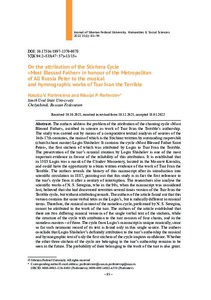К проблеме атрибуции цикла стихир «Отче преблаженне» в честь митрополита всея Руси Петра музыкально-гимнографическому творчеству царя Ивана Грозного
Скачать файл:
URI (для ссылок/цитирований):
https://elib.sfu-kras.ru/handle/2311/145114Автор:
Парфентьева, Н. В.
Парфентьев, Н. П.
Parfentieva, Natalia V.
Parfentiev, Nikolai P.
Дата:
2022-01Журнал:
Журнал Сибирского федерального университета. Гуманитарные науки. Journal of Siberian Federal University. Humanities & Social Sciences; 2022 15 (1)Аннотация:
Авторы статьи обращаются к проблеме атрибуции певческого
цикла «Отче преблаженне», приписываемого в науке творчеству царя Ивана
Грозного. Исследование проведено путем сравнительного текстологического
анализа источников XVI–XVII вв., важнейшим из которых является Стихирарь
письма знаменитого распевщика Логина Шишелова. Этот сборник и содержит
данный цикл, первая стихира которого ремаркой атрибутирована царю Ивану.
В статье приводится история бытования рукописи после ее введения в научный
оборот в 1887 г. Настоящее исследование по сути первое обращение к циклу
Грозного из логиновской рукописи после многолетнего перерыва. Исследователи
особо анализируют работы Н. С. Серегиной, которая в то время, когда рукопись
считалась утерянной, полагала, что обнаружила списки цикла Грозного, но без
атрибутирующих ремарок. Выяснилось, что эти списки содержат те же словесные
тексты, что и у Логина, но в музыкальном отношении полностью различаются.
Поэтому авторы полагают, что выполненную Н. С. Серегиной расшифровку
музыкального содержания безымянного цикла нельзя отнести к творчеству Грозного.
Установлено, что существуют два различающихся музыкальных воплощения
единого словесного текста стихир, при этом структура цикла с атрибуцией
царю состоит из четырех песнопений, а у безымянных мастеров – из трех. Цикл
из рукописи Логина уникален в музыкальном отношении, его невменная запись
обнаруживается только в этом единственном источнике. Авторы приходят
к заключению, что ремарка, которой Логин Шишелов со всей определенностью
атрибутировал царю музыкально-гимнографический
текст лишь первой стихиры
цикла, вызывает доверие. Принадлежат ли три другие стихиры цикла авторству
Грозного, предстоит выяснить в дальнейшем. Вероятность их принадлежности
творчеству царя также велика The authors address the problem of the attribution of the chanting cycle «Most Blessed Father», ascribed in science as work of Tsar Ivan the Terrible’s authorship. The study was carried out by means of a comparative textual analysis of sources of the 16th‑17th centuries, the main of which is the Stichirar writtten by outstanding raspevshik (church chant master) Login Shishelov. It contains the cycle «Most Blessed Father Saint Peter», the first stichera of which was attributed by Login to Tsar Ivan the Terrible. The preservation of the tsar’s musical creation by Login Shishelov is one of the most important evidence in favour of the reliability of this attribution. It is established that in 1585 Login was a monk of the Chudov Monastery, located in the Moscow Kremlin, and could have the opportunity to obtain written evidence of the work of Tsar Ivan the Terrible. The authors reveals the history of this manuscript after its introduction into scientific circulation in 1887, pointing out that this study is in fact the first reference to the tsar’s cycle from it after a century of interruption. The researchers also analyse the scientific works of N. S. Seregina, who in the 90s, when the manuscript was considered lost, believed that she had discovered rewritten several times version of the Tsar Ivan the Terrible cycle, but without attributing remark. The authors of the article found out that this version contains the same verbal texts as the Login’s, but is radically different in musical terms. Therefore, the musical content of the nameless cycle, performed by N. S. Seregina, cannot be attributed to the work of the tsar. The authors of the article established that there are two differing musical versions of the single verbal text of the stichera, while the structure of the cycle with attribution to the tsar consists of four chants, and in the nameless masters – of three. The cycle from Login’s manuscript is unique musically, since so far such neumanic record of its text is found only in this single source. The authors conclude that Login Shishelov’s definitely attribution to the tsar’s authorship the musical and hymnographic text of only the first stichera of the cycle inspires confidence. Whether the other three stichera of the cycle are belonging to the tsar’s authorship remains to be seen in the future. The probability of their belonging to the work of the tsar is also great

